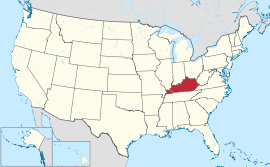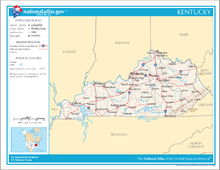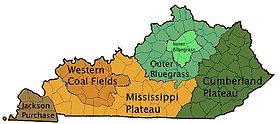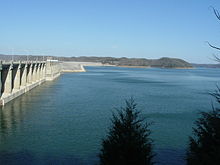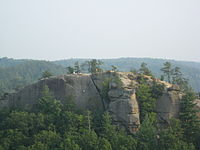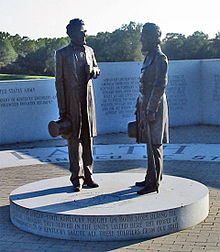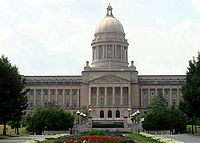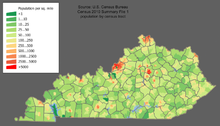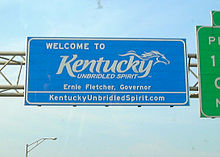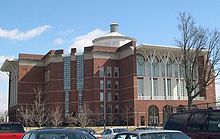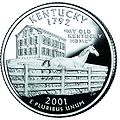- Kentucky
-
This article is about the Commonwealth of Kentucky. For other uses, see Kentucky (disambiguation).
Commonwealth of Kentucky 

Flag Seal Nickname(s): Bluegrass State Motto(s): United we stand, divided we fall Official language(s) English[1] Demonym Kentuckian Capital Frankfort Largest city Louisville Largest metro area Louisville metropolitan area Area Ranked 37th in the U.S. - Total 40,409 sq mi
(104,659 km2)- Width 140 miles (225 km) - Length 379 miles (610 km) - % water 1.7 - Latitude 36° 30′ N to 39° 09′ N - Longitude 81° 58′ W to 89° 34′ W Population Ranked 26th in the U.S. - Total 4,339,367 (2010 Census)[2] - Density 109.9/sq mi (41.46/km2)
Ranked 24th in the U.S.Elevation - Highest point Black Mountain[3][4]
4,145 ft (1263 m)- Mean 750 ft (230 m) - Lowest point Mississippi River at Kentucky Bend[3][4]
257 ft (78 m)Before statehood Kentucky County, Virginia Admission to Union June 1, 1792 (15th) Governor Steve Beshear (D) Lieutenant Governor Daniel Mongiardo (D) Legislature General Assembly - Upper house Senate - Lower house House of Representatives U.S. Senators Mitch McConnell (R)
Rand Paul (R)U.S. House delegation 4 Republicans, 2 Democrats (list) Time zones - eastern half Eastern: UTC-5/DST-4 - western half Central: UTC-6/DST-5 Abbreviations KY US-KY Website kentucky.gov The Commonwealth of Kentucky
 i/kɨnˈtʌki/ is a state located in the East Central United States of America. As classified by the United States Census Bureau, Kentucky is a Southern state, more specifically in the East South Central region. Kentucky is one of four U.S. states constituted as a commonwealth (the others being Virginia, Pennsylvania, and Massachusetts). Originally a part of Virginia, in 1792 Kentucky became the 15th state to join the Union. Kentucky is the 37th largest state in terms of total area, the 36th largest in land area, and ranks 26th in population.
i/kɨnˈtʌki/ is a state located in the East Central United States of America. As classified by the United States Census Bureau, Kentucky is a Southern state, more specifically in the East South Central region. Kentucky is one of four U.S. states constituted as a commonwealth (the others being Virginia, Pennsylvania, and Massachusetts). Originally a part of Virginia, in 1792 Kentucky became the 15th state to join the Union. Kentucky is the 37th largest state in terms of total area, the 36th largest in land area, and ranks 26th in population.Kentucky is known as the "Bluegrass State", a nickname based on the fact that bluegrass is present in many of the pastures throughout the state, based on the fertile soil. It made possible the breeding of high-quality livestock, especially thoroughbred racing horses. It is a land with diverse environments and abundant resources, including the world's longest cave system, Mammoth Cave National Park; the greatest length of navigable waterways and streams in the contiguous United States; and the two largest man-made lakes east of the Mississippi River. It is also home to the highest per capita number of deer and turkey in the United States, the largest free-ranging elk herd east of Montana, and the nation's most productive coalfield. Kentucky is also known for horse racing, bourbon distilleries, bluegrass music, automobile manufacturing, tobacco and college basketball.
Contents
Origin of name
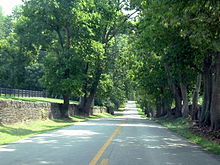 Narrow country roads bounded by stone and wood plank fences are a fixture in the Kentucky Bluegrass region.
Narrow country roads bounded by stone and wood plank fences are a fixture in the Kentucky Bluegrass region.
It is generally accepted that the historic Native American tribes who hunted in what is now Kentucky referred to the region as Catawba, or some similar variant. There is also a tradition that some tribes referred to the area as "The Dark and Bloody Ground".[citation needed] Some have said that the land was described in this way to Daniel Boone by a native Chief. According to The Kentucky Blue Book,[citation needed] Dragging Canoe, a young Cherokee chief opposed to selling ancestral hunting grounds, warned the whites that they were purchasing a "dark and bloody ground." The origin of Kentucky's modern name (variously spelled Cane-tuck-ee, Cantucky, Kain-tuck-ee, and Kentuckee before its modern spelling was accepted)[5] comes from an Iroquois word meaning "meadow lands", referring to the buffalo hunting grounds in Central Kentucky's savanna. Members of the Haudenosaunee, the Iroquois Confederacy, were historically based in New York and Pennsylvania. They penetrated to this area of the Ohio River Valley and drove other tribes out in order to control more hunting land. In addition to buffalo, they trapped beaver for the lucrative fur trade with the French and English, long before European-American settlement in this area.[6]
Geography
See also: List of Kentucky counties and Coal mining in KentuckyKentucky is considered to be situated in the Upland South. It is infrequently included in the Midwest.[7][8] A significant portion of eastern Kentucky is part of Appalachia.
Kentucky borders seven states, from the Midwest and the Southeast. West Virginia lies to the east, Virginia to the southeast, Tennessee to the south, Missouri to the west, Illinois and Indiana to the northwest, and Ohio to the north and northeast. Only Missouri and Tennessee, both of which border eight states, touch more states.
Kentucky's northern border is formed by the Ohio River and its western border by the Mississippi River. The official state borders are based on the courses of the rivers as they existed when Kentucky became a state in 1792. In several places, the rivers have changed courses away from the original borders. For instance, northbound travelers on US 41 from Henderson, after crossing the Ohio River, will be in Kentucky for about a half-mile (800 m) longer on the north side. Ellis Park, a thoroughbred racetrack, is located in this small piece of Kentucky. Waterworks Road is part of the only land border between Indiana and Kentucky.[9]
Kentucky is the only U.S. state to have a non-contiguous part existing as an exclave surrounded by other states. Fulton County, in the far west corner of the state, includes Kentucky Bend. This small part of Kentucky on the Mississippi River, bordered by Missouri and accessible via Tennessee, was created by the 1812 New Madrid Earthquake changing the course of the river.[10]
Regions
Kentucky can be divided into five primary regions: the Cumberland Plateau in the east, the north-central Bluegrass region, the south-central and western Pennyroyal Plateau, the Western Coal Fields and the far-west Jackson Purchase. The Bluegrass region is commonly divided into two regions, the Inner Bluegrass—the encircling 90 miles (145 km) around Lexington—and the Outer Bluegrass—the region that contains most of the Northern portion of the state, above the Knobs. Much of the outer Bluegrass is in the Eden Shale Hills area, made up of short, steep, and very narrow hills. This map is a rough depiction of the regions because it relies largely on county lines; as a result, the Inner Bluegrass appears larger than it is, and the Cumberland Plateau appears slightly smaller. The latter region is more commonly known in Kentucky as the East Kentucky Coal Field. Note the singular; these regions are not the sites of coal "fields" but one continuous field with many overlapping seams; the West Kentucky Coal Field is part of the Illinois Basin.
-
Kentucky's Inner Bluegrass region features hundreds of horse farms
-
The Jackson Purchase and western Pennyrile are home to several bald cypress/tupelo swamps
-
The East Kentucky Coal Field is known for its rugged terrain
Climate
Located within the southeastern interior portion of North America, Kentucky has a climate that can best be described as a humid subtropical climate (Koppen Cfa). Monthly average temperatures in Kentucky range from a summer daytime high of 87 °F (31 °C) to a winter low of 23 °F (−5 °C). The average precipitation is 46 inches (1,200 mm) a year.[11] Kentucky experiences all four seasons, usually with striking variations in the severity of summer and winter from year to year.[12] Kentucky's highest recorded temperature was 114 °F (46 °C) at Greensburg on July 28, 1930 while the lowest recorded temperature was −34 °F (−37 °C) at Cynthiana on January 28, 1963.
Major weather events that have affected Kentucky include:
Event Death Toll Louisville Tornado of 1890 est. 76–120+ Ohio River flood of 1937 ? April 3, 1974 Tornado Outbreak 72 April 7, 1977 Flooding (Cumberland River toppled Pineville floodwall) ? March 1, 1997 Flooding 18 North American blizzard of 2003 ? 2008 Super Tuesday tornado outbreak Weather.com reported 17 deaths September 2008 Windstorm 1 January 2009 ice storm 24+ Monthly Average High and Low Temperatures For Various Kentucky Cities City Jan Feb Mar Apr May Jun Jul Aug Sep Oct Nov Dec Lexington 40/24 45/28 55/36 65/44 74/54 82/62 86/66 85/65 78/58 67/46 54/37 44/28 Louisville 41/25 47/28 57/37 67/46 75/56 83/65 87/70 86/68 79/61 68/48 56/39 45/30 Paducah 42/24 48/28 58/37 68/46 77/55 85/64 89/68 87/65 81/57 71/45 57/36 46/28 Pikeville 46/23 50/25 60/32 69/39 77/49 84/58 87/63 86/62 80/56 71/42 60/33 49/26 Ashland 42/19 47/21 57/29 68/37 77/47 84/56 88/61 87/59 80/52 69/40 57/31 46/23 Lakes and rivers
Kentucky's 90,000 miles (140,000 km) of streams provides one of the most expansive and complex stream systems in the nation. Kentucky has both the largest artificial lake east of the Mississippi in water volume (Lake Cumberland) and surface area (Kentucky Lake). It is the only U.S. state to be bordered on three sides by rivers—the Mississippi River to the west, the Ohio River to the north, and the Big Sandy River and Tug Fork to the east.[13] Its major internal rivers include the Kentucky River, Tennessee River, Cumberland River, Green River and Licking River.
Though it has only three major natural lakes,[14] the state is home to many artificial lakes. Kentucky also has more navigable miles of water than any other state in the union, other than Alaska.[15]
Natural environment and conservation
Kentucky has an expansive park system which includes one national park, two National Recreation areas, two National Historic Parks, two national forests, two National Wildlife Refuges, 45 state parks, 37,696 acres (153 km2) of state forest, and 82 Wildlife Management Areas.
Kentucky has been part of two of the most successful wildlife reintroduction projects in United States history. In the winter of 1997, the Kentucky Department of Fish and Wildlife Resources began to re-stock elk in the state's eastern counties, which had been extinct from the area for over 150 years. As of 2009, the herd had reached the project goal of 10,000 animals, making it the largest herd east of the Mississippi River.[16]
The state also stocked wild turkeys in the 1950s. Once extinct here, more wild turkeys thrive in Kentucky today than in any other eastern state. Hunters telechecked a record 29,006 birds taken during the 23-day season in Spring 2009. Only bearded turkeys were allowed to be hunted; the females are protected for breeding.[17]
In March 2011, Kentucky was rated last place amongst the states in the American State Litter Scorecard, presented at the American Society for Public Administration national conference.[18]
Significant natural attractions
Red River Gorge is one of Kentucky's most visited places
- Cumberland Gap, chief passageway through the Appalachian Mountains in early American history.
- Cumberland Falls State Park, the only place in the Western Hemisphere where a "moon-bow" may be regularly seen, due to the spray of the falls.[19]
- Mammoth Cave National Park, featuring the world's longest known cave system.[20]
- Red River Gorge Geological Area, part of the Daniel Boone National Forest.
- Land Between the Lakes, a National Recreation Area managed by the United States Forest Service.
- Big South Fork National River and Recreation Area near Whitley City.
- Black Mountain, state's highest point.[21] Runs along the border of Harlan and Letcher counties.
- Bad Branch Falls State Nature Preserve, 2,639-acre (11 km2) state nature preserve on southern slope of Pine Mountain in Letcher County. Includes one of the largest concentrations of rare and endangered species in the state,[22] as well as a 60-foot (18 m) waterfall and a Kentucky Wild River.
- Jefferson Memorial Forest, located in the southern fringes of Louisville in the Knobs region, the largest municipally run forest in the United States.[23]
- Lake Cumberland, 1,255 miles (2,020 km) of shoreline located in South Central Kentucky.
- Natural Bridge, located in Slade, Kentucky Powell County
- Breaks Interstate Park, located in southeastern Pike County, Kentucky and Southwestern Virginia. The Breaks is commonly known as the "Grand Canyon of the South."
History
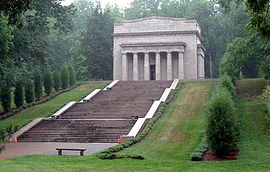 Abraham Lincoln Birthplace near Hodgenville
Abraham Lincoln Birthplace near Hodgenville Main article: History of Kentucky
Main article: History of KentuckyAlthough inhabited by Native Americans from at least 1000 BC to about 1650 AD, when European and colonial explorers and settlers began entering Kentucky in greater number in the mid-18th century, there were no major Native American settlements in the region. The Shawnees from the north and Cherokees from the south sent parties into the area regularly for hunting. As more settlers entered the area, warfare broke out because the American Indians saw settlers' attempts to own land to be encroachment on their traditional hunting grounds.[24] The Southern Cherokee Nation of Kentucky still lives in Kentucky today as a state Recognized Tribe.
According to a 1790 U.S. government report, 1,500 Kentucky settlers had been killed in Indian raids since the end of the Revolutionary War.[25] In an attempt to end these raids, Clark led an expedition of 1,200 drafted men against Shawnee towns on the Wabash River in 1786, one of the first actions of the Northwest Indian War.[26]
After the American Revolution, the counties of Virginia beyond the Appalachian Mountains became known as Kentucky County.[27] Eventually, the residents of Kentucky County petitioned for a separation from Virginia. Ten constitutional conventions were held in the Constitution Square Courthouse in Danville between 1784 and 1792. In 1790, Kentucky's delegates accepted Virginia's terms of separation, and a state constitution was drafted at the final convention in April 1792. On June 1, 1792, Kentucky became the fifteenth state to be admitted to the union. Isaac Shelby, a military veteran from Virginia, was elected the first Governor of the Commonwealth of Kentucky.[28]
Kentucky was a border state during the American Civil War.[29] Although frequently described as never having seceded, representatives from several counties met at Russellville calling themselves the "Convention of the People of Kentucky" and passed an Ordinance of Secession on November 20, 1861.[30] They established a Confederate government of Kentucky with its capital in Bowling Green.[31] Though Kentucky was represented by the central star on the Confederate battle flag,[32] the Russellville Convention did not represent the majority of residents. A year earlier, philosopher Karl Marx wrote to Friedrich Engels that the result of a vote deciding how Kentucky would be represented at a convention of the border states was "100,000 for the Union ticket, only a few thousand for secession."[33] Kentucky officially remained "neutral" throughout the war due to Union sympathies of many of the Commonwealth's citizens. Confederate Memorial Day is observed by some in Kentucky on Confederate President Jefferson Davis' birthday, June 3.[34]
 Designed by the Washington Monument's architect Robert Mills in 1845, the U.S. Marine Hospital in Louisville is considered the best remaining antebellum hospital in the United States
Designed by the Washington Monument's architect Robert Mills in 1845, the U.S. Marine Hospital in Louisville is considered the best remaining antebellum hospital in the United States
The Black Patch Tobacco Wars, a vigilante action, occurred in the area in the early 20th century. As result of the tobacco industry monopoly, tobacco farmers in the area were forced to sell their tobacco at low prices. Many local farmers and activists united to refuse to sell tobacco to the tobacco industry. A vigilante wing, the "Night Riders", terrorized farmers who sold their tobacco at the low prices demanded by the tobacco corporations. They burned several tobacco warehouses, notably in Hopkinsville and Princeton. In the later period of their operation, they were known to physically assault farmers in the middle of the night who broke the boycott. The Governor declared martial law and deployed the Kentucky Militia to end the Black Patch Tobacco Wars.
On January 30, 1900, Governor William Goebel, flanked by two bodyguards and walking to the State Capitol in downtown Frankfort, was mortally wounded by an assassin. Goebel was contesting the election of 1899, which William S. Taylor was initially believed to have won. For several months, J. C. W. Beckham, Goebel's running mate, and Taylor fought over who was the legal governor, until the Supreme Court of the United States ruled in May in favor of Beckham. After fleeing to Indiana, Taylor was indicted as a co-conspirator in Goebel's assassination. Goebel is the only governor of a U.S. state to have been assassinated while in office.[35]
Law and government
Kentucky is one of four U.S. states to officially use the term commonwealth, which it inherited from Virginia. Kentucky is also one of only five states that elects its state officials in odd-numbered years (the others are Louisiana, Mississippi, New Jersey, and Virginia). Kentucky holds elections for these offices every 4 years in the years preceding Presidential election years. Thus, the last year when Kentucky elected a Governor was 2011; the next gubernatorial election will occur in 2015, with future gubernatorial elections to take place in 2019, 2023, 2027, etc.
Executive branch
 The governor's mansion in Frankfort, Kentucky
The governor's mansion in Frankfort, Kentucky
The executive branch is headed by the governor who serves as both head of state and head of government. The lieutenant governor may or may not have executive authority depending on whether the person is a member of the Governor's cabinet. Under the current Kentucky Constitution, the lieutenant governor assumes the duties of the governor only if the governor is incapacitated. (Prior to 1992, the lieutenant governor assumed power any time the governor was out of the state.) The governor and lieutenant governor usually run on a single ticket (also per a 1992 constitutional amendment), and are elected to four-year terms. Currently, the governor and lieutenant governor are Democrats Steve Beshear and Daniel Mongiardo.
Other elected constitutional offices include: the Secretary of State, Attorney General, Auditor of Public Accounts, State Treasurer and Commissioner of Agriculture. Currently, Democrat Elaine N. Walker serves as the Secretary of State. The commonwealth's chief prosecutor, law enforcement officer, and law officer is the attorney general. The current Kentucky attorney general is Democrat Jack Conway. The Auditor of Public Accounts is held by Democrat Crit Luallen. Democrat Todd Hollenbach is the current Treasurer. Former University of Kentucky basketball player Richie Farmer, a Republican, serves as the current Commissioner of Agriculture.
Legislative branch
Kentucky's legislative branch consists of a bicameral body known as the Kentucky General Assembly.
The Senate is considered the upper house. It has 38 members, and is led by the President of the Senate, currently Republican David L. Williams.
The House of Representatives has 100 members, and is led by the Speaker of the House, currently Democrat Greg Stumbo.
Judicial branch
The judicial branch of Kentucky is called the Kentucky Court of Justice and comprises courts of limited jurisdiction called District Courts; courts of general jurisdiction called Circuit Courts; specialty courts such as Drug Court, Family Court; an intermediate appellate court, the Kentucky Court of Appeals; and a court of last resort, the Kentucky Supreme Court.
The Kentucky Court of Justice is headed by the Chief Justice of the Commonwealth.
Unlike federal judges, who are usually appointed, justices serving on Kentucky state courts are chosen by the state's populace in non-partisan elections.
Federal representation
Kentucky's two Senators are Senate Minority Leader Mitch McConnell and Rand Paul, both Republicans. The state is divided into six Congressional Districts, represented by Republicans Ed Whitfield (1st), Brett Guthrie (2nd), Geoff Davis (4th), and Hal Rogers (5th), and Democrats John Yarmuth (3rd) and Ben Chandler (6th).
A map showing Kentucky's six congressional districts
Judicially, Kentucky is split into two Federal court districts: the Kentucky Eastern District and the Kentucky Western District. Appeals are heard in the Sixth Circuit Court of Appeals based in Cincinnati, Ohio.
Law
Kentucky's body of laws, known as the Kentucky Revised Statutes (KRS), were enacted in 1942 to better organize and clarify the whole of Kentucky law.[36] The statutes are enforced by local police, sheriffs and deputy sheriffs, and constables and deputy constables. Unless they have completed a police academy elsewhere, these officers are required to complete training at the Kentucky Department of Criminal Justice Training Center on the campus of Eastern Kentucky University.[37] Additionally, in 1948, the Kentucky General Assembly established the Kentucky State Police, making it the 38th state to create a force whose jurisdiction extends throughout the given state.[38]
Kentucky is one of 36 states in the United States that sanctions the death penalty for certain crimes. Those convicted of capital crimes after March 31, 1998 are always executed by lethal injection; those convicted before this date may opt for the electric chair.[39] Only three people have been executed in Kentucky since the U.S. Supreme Court re-instituted the practice in 1976. The most notable execution in Kentucky, however, was that of Rainey Bethea on August 14, 1936. Bethea was publicly hanged in Owensboro for the rape and murder of Lischia Edwards.[40] Irregularities with the execution led to this becoming the last public execution in the United States.[41]
Kentucky has been on the front lines of the debate over displaying the Ten Commandments on public property. In the 2005 case of McCreary County v. ACLU of Kentucky, the U.S. Supreme Court upheld the decision of the Sixth Circuit Court of Appeals that a display of the Ten Commandments in the Whitley City courthouse of McCreary County was unconstitutional.[42] Later that year, Judge Richard Fred Suhrheinrich, writing for the Sixth Circuit Court of Appeals in the case of ACLU of Kentucky v. Mercer County, wrote that a display including the Mayflower Compact, the Declaration of Independence, the Ten Commandments, the Magna Carta, The Star-Spangled Banner, and the national motto could be erected in the Mercer County courthouse.[43]
Kentucky has also been known to have unusually high political candidacy age laws, especially compared to surrounding states. The origin of this is unknown, but it has been suggested it has to do with the commonwealth tradition.
Politics
Further information: Political party strength in KentuckyPresidential elections results[44] Year Republicans Democrats 2008 57.37% 1,048,462 41.15% 751,985 2004 59.55% 1,069,439 39.69% 712,733 2000 56.50% 872,492 41.37% 638,898 1996 44.88% 623,283 45.84% 636,614 1992 41.34% 617,178 44.55% 665,104 1988 55.52% 734,281 43.88% 580,368 1984 60.04% 822,782 39.37% 539,589 1980 49.07% 635,274 47.61% 616,417 1976 45.57% 531,852 52.75% 615,717 1972 63.37% 676,446 34.77% 371,159 1968 43.79% 462,411 37.65% 397,541 1964 35.65% 372,977 64.01% 669,659 1960 53.59% 602,607 46.41% 521,855 Where politics are concerned, Kentucky historically has been very hard fought and leaned slightly toward the Democratic Party, although it was never included among the "Solid South". In 2006, 57.05% of the state's voters were officially registered as Democrats, 36.55% registered Republican, and 6.39% registered with some other political party.[45] Despite this, the state often supports Republican candidates for federal offices.
From 1964 through 2004, Kentucky voted for the eventual winner of the election for President of the United States. In the 2008 election, however, the state lost its bellwether status when John McCain, who won Kentucky, lost the national popular and electoral vote to Barack Obama (McCain carried Kentucky 57 to 41%). The Commonwealth supported the previous three Democratic candidates elected to the White House, all elected from Southern states: Lyndon B. Johnson (Texas) in 1964, Jimmy Carter (Georgia) in 1976, and Bill Clinton (Arkansas) in 1992 and 1996. In presidential elections, the state has become a Republican stronghold, supporting that party's presidential candidates by double-digit margins in 2000, 2004 and 2008. At the state level and in most local areas, the Democratic Party is the dominant party.[citation needed]
Voter Registration and Party Enrollment as of June 26, 2010[46] Party Number of Voters Percentage Democratic 1,619,391 56.59% Republican 1,052,902 36.79% Other 189,499 6.62% Total 2,861,792 100% Demographics
Main article: Demographics of KentuckyHistorical populations Census Pop. %± 1790 73,677 — 1800 220,955 199.9% 1810 406,511 84.0% 1820 564,317 38.8% 1830 687,917 21.9% 1840 779,828 13.4% 1850 982,405 26.0% 1860 1,155,684 17.6% 1870 1,321,011 14.3% 1880 1,648,690 24.8% 1890 1,858,635 12.7% 1900 2,147,174 15.5% 1910 2,289,905 6.6% 1920 2,416,630 5.5% 1930 2,614,589 8.2% 1940 2,845,627 8.8% 1950 2,944,806 3.5% 1960 3,038,156 3.2% 1970 3,218,706 5.9% 1980 3,660,777 13.7% 1990 3,685,296 0.7% 2000 4,041,769 9.7% 2010 4,339,367 7.4% Source: 1790-2000[47] 1910-2010[48] As of July 1, 2006, Kentucky has an estimated population of 4,206,074, which is an increase of 33,466, or 0.8%, from the prior year and an increase of 164,586, or 4.1%, since the year 2000. This includes a natural increase since the last census of 77,156 people (that is 287,222 births minus 210,066 deaths) and an increase due to net migration of 59,604 people into the state. Immigration from outside the United States resulted in a net increase of 27,435 people, and migration within the country produced a net increase of 32,169 people. As of 2004, Kentucky's population included about 95,000 foreign-born persons (2.3%). The population density of the state is 101.7 people per square mile.[49]
Kentucky's total population has grown during every decade since records began. However, during most decades of the 20th century there was also net out-migration from Kentucky. Since 1900, rural Kentucky counties have experienced a net loss of over 1 million people from migration, while urban areas have experienced a slight net gain.[50]
The center of population of Kentucky is located in Washington County, in the city of Willisburg.[51]
Race and ancestry
The largest ancestries in the commonwealth are: English (30.6%), German (12.7%), Irish (10.5%), and African American (7.8%).[52][53] In the state's most urban counties of Jefferson, Oldham, Fayette, Boone, Kenton, and Campbell, German is the largest reported ancestry. Americans of Scots-Irish and English stock are present throughout the entire state, and many claim Irish ancestry because of the term "Scots-Irish", but most of the time in Kentucky this term is used for those with Scottish roots, rather than Irish.[54] Southeastern Kentucky was populated by a large group of Native Americans of mixed heritage, also known as Melungeons, in the early 19th century. Groups like the Ridgetop Shawnee were organizing the descendants of those early Native American settlers.
African Americans, who made up one-fourth of Kentucky's population prior to the Civil War, declined in number as many moved to the industrial North in the Great Migration. Today, the African American population of Jefferson County is 20%; 44.2% of Kentucky's African American population is in Jefferson County and 52% are in the Louisville Metro Area. Other areas with high concentrations, besides Christian and Fulton Counties, are the city of Paducah, the Bluegrass, and the city of Lexington. Many mining communities in far Southeastern Kentucky also have populations between five and 10 percent African American.
Demographics of Kentucky (csv) By race White Black AIAN* Asian NHPI* 2000 (total population) 91.53% 7.76% 0.61% 0.92% 0.08% 2000 (Hispanic only) 1.35% 0.10% 0.04% 0.02% 0.01% 2005 (total population) 91.27% 7.98% 0.58% 1.10% 0.08% 2005 (Hispanic only) 1.80% 0.12% 0.04% 0.03% 0.01% Growth 2000–05 (total population) 2.97% 6.16% -2.21% 23.46% 9.78% Growth 2000–05 (non-Hispanic only) 2.44% 5.94% -3.28% 23.07% 7.98% Growth 2000–05 (Hispanic only) 37.97% 22.34% 13.51% 38.48% 19.80% * AIAN is American Indian or Alaskan Native; NHPI is Native Hawaiian or Pacific Islander Religion
In 2000, The Association of Religion Data Archives reported[55] that of Kentucky's 4,041,769 residents:
- 47% were not affiliated with any church
- 34% were members of Evangelical Protestant churches
- Southern Baptist Convention (979,994 members, 24%)
- Christian churches and churches of Christ (106,638 members, 3%)
- Churches of Christ (58,602 members, 1%)
- 10% were Roman Catholics
- 9% belonged to mainline Protestant churches
- United Methodist Church (208,720 members, 5%)
- Christian Church (Disciples of Christ) (67,611 members, 2%)
- 0.05% were Orthodox Christians
- 1% were affiliated with other theologies.
Today Kentucky is home to several seminaries. Southern Baptist Theological Seminary in Louisville is the principal seminary for the Southern Baptist Convention. Louisville is also the home of the Louisville Presbyterian Theological Seminary. Lexington has two seminaries, Lexington Theological Seminary, and the Baptist Seminary of Kentucky. Asbury Theological Seminary is located in nearby Wilmore. In addition to seminaries, there are several colleges affiliated with denominations. Transylvania in Lexington is affiliated with the Disciples of Christ. The University of Pikeville in Pikeville, Kentucky is affiliated with the Presbyterian Church. In Louisville, Bellarmine and Spalding are affiliated with the Roman Catholic Church. In Owensboro, Kentucky, Kentucky Wesleyan College is associated with the Methodist Church and Brescia University is associated with the Roman Catholic Church. Wilmore is home to Asbury University (a separate institution from the seminary), which is associated with the Christian College Consortium. The University of the Cumberlands, located in Williamsburg, Campbellsville University in Campbellsville, Georgetown College in Georgetown and Mid-Continent University in Mayfield all have connections with the Southern Baptist Convention. Louisville is also home to the headquarters of the Presbyterian Church (USA) and their printing press. Louisville is also home to a sizable Muslim[56] and Jewish population.
Economy
 The best selling car in the United States, the Toyota Camry, is manufactured in Georgetown, Kentucky.
The best selling car in the United States, the Toyota Camry, is manufactured in Georgetown, Kentucky.
 The best selling truck in the United States, the Ford F-Series, is manufactured in Louisville, Kentucky.
The best selling truck in the United States, the Ford F-Series, is manufactured in Louisville, Kentucky.
Early in its history Kentucky gained recognition for its excellent farming conditions. It was the site of the first commercial winery in the United States (started in present day Jessamine County in 1799) and due to the high calcium content of the soil in the Bluegrass region quickly became a major horse breeding (and later racing) area. Today Kentucky ranks 5th nationally in goat farming, 8th in beef cattle production,[57] and 14th in corn production.[58]
Today Kentucky's economy has expanded to importance in non agricultural terms as well, especially in auto manufacturing, energy fuel production, and medical facilities.As of 2010 24% of electricity produced in the USA depended on either enriched uranium rods coming from the Paducah Gaseous Diffusion Plant (the only domestic site of low grade uranium enrichment), or from the 107,336 tons of coal extracted from the state's two coal fields (which combined produce 4% percent of the electricity in the United States).[59] Kentucky ranks 4th among U.S. states in the number of automobiles and trucks assembled.[60] The Chevrolet Corvette, Cadillac XLR (2004–2009), Ford Explorer, Ford Super Duty trucks, Ford Excursion (2000–2005), Toyota Camry, Toyota Avalon, Toyota Solara, and Toyota Venza are assembled in Kentucky.
The total gross state product for 2010 was $163.3 billion, 28th in the nation.[61] Its per-capita personal income was US$28,513, 43rd in the nation.[62]
As of October 2010, the state's unemployment rate is 10%.[63]
Taxation
There are six income tax brackets, ranging from 2% to 6% of personal income.[64] The sales tax rate in Kentucky is 6%.[65] Kentucky has a broadly based classified property tax system. All classes of property, unless exempted by the Constitution, are taxed by the state, although at widely varying rates.[66] Many of these classes are exempted from taxation by local government. Of the classes that are subject to local taxation, three have special rates set by the General Assembly, one by the Kentucky Supreme Court and the remaining classes are subject to the full local rate, which includes the tax rate set by the local taxing bodies plus all voted levies. Real property is assessed on 100% of the fair market value and property taxes are due by December 31. Once the primary source of state and local government revenue, property taxes now account for only about 6% of the Kentucky's annual General Fund revenues.[67]
Until January 1, 2006, Kentucky imposed a tax on intangible personal property held by a taxpayer on January 1 of each year. The Kentucky intangible tax was repealed under House Bill 272.[68] Intangible property consisted of any property or investment which represents evidence of value or the right to value. Some types of intangible property included: bonds, notes, retail repurchase agreements, accounts receivable, trusts, enforceable contracts sale of real estate (land contracts), money in hand, money in safe deposit boxes, annuities, interests in estates, loans to stockholders, and commercial paper.
"Unbridled Spirit"
To boost Kentucky's image, give it a consistent reach, and help Kentucky "stand out from the crowd", former Governor Ernie Fletcher launched a comprehensive branding campaign with the hope of making its $12 – $14 million advertising budget more effective. The "Unbridled Spirit" brand was the result of a $500,000 contract with New West, a Kentucky-based public relations advertising and marketing firm to develop a viable brand and tag line. The Fletcher administration aggressively marketed the brand in both the public and private sectors. The "Welcome to Kentucky" signs at border areas have Unbridled Spirit's symbol on them.
The previous campaign was neither a failure nor a success. Kentucky's "It's that friendly" slogan hoped to draw more people into the state based on the idea of southern hospitality. Though it was meant to embrace southern values, most Kentuckians rejected it as cheesy and ineffective. It was quickly seen that it was also not an image that encouraged tourism as much as initially hoped for. Therefore it was necessary to reconfigure a slogan to embrace Kentucky as a whole while also encouraging more people to visit the Bluegrass.[69]
Transportation
- Main article: Transportation in Kentucky.
Roads
 At 464 miles (747 km) long, Kentucky Route 80 is the longest route in Kentucky, pictured here west of Somerset.
At 464 miles (747 km) long, Kentucky Route 80 is the longest route in Kentucky, pictured here west of Somerset.
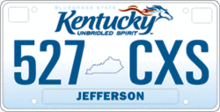 The current state license plate design, introduced in 2005.
The current state license plate design, introduced in 2005. See also: List of Kentucky State Highways
See also: List of Kentucky State HighwaysKentucky is served by five major interstate highways (I-75, I-71, I-64, I-65, I-24), nine parkways, and three bypasses and spurs. The parkways were originally toll roads, but on November 22, 2006, Governor Ernie Fletcher ended the toll charges on the William H. Natcher Parkway and the Audubon Parkway, the last two parkways in Kentucky to charge tolls for access.[70] The related toll booths have been demolished.[71]
Ending the tolls some seven months ahead of schedule was generally agreed to have been a positive economic development for transportation in Kentucky. In June 2007, a law went into effect raising the speed limit on rural portions of Kentucky Interstates from 65 to 70 miles per hour (105 to 110 km/h).[72]
Greyhound provides bus service to most major towns in the state.
Rails
 High Bridge over the Kentucky River was the tallest rail bridge in the world when it was completed in 1877.
High Bridge over the Kentucky River was the tallest rail bridge in the world when it was completed in 1877. See also: List of Kentucky railroads
See also: List of Kentucky railroadsAmtrak, the national passenger rail system, provides service to Ashland, South Portsmouth, Maysville and Fulton. The Cardinal (trains 50 and 51) is the line that offers Amtrak service to Ashland, South Shore, Maysville and South Portsmouth. The City of New Orleans (trains 58 and 59) serve Fulton. The Northern Kentucky area is served by the Cardinal at the Cincinnati Museum Center at Union Terminal. The Museum Center is just across the Ohio River in Cincinnati.
As of 2004, there were approximately 2,640 miles (4,250 km) of railways in Kentucky, with about 65% of those being operated by CSX Transportation. Coal was by far the most common cargo, accounting for 76% of cargo loaded and 61% of cargo delivered.[73]
Bardstown features a tourist attraction known as My Old Kentucky Dinner Train. Run along a 20-mile (30 km) stretch of rail purchased from CSX in 1987, guests are served a four-course meal as they make a two-and-a-half hour round-trip between Bardstown and Limestone Springs.[74] The Kentucky Railway Museum is located in nearby New Haven.[75]
Other areas in Kentucky are reclaiming old railways in rail trail projects. One such project is Louisville's Big Four Bridge. If completed, the Big Four Bridge rail trail will contain the second longest pedestrian-only bridge in the world.[76] The longest pedestrian-only bridge is also found in Kentucky—the Newport Southbank Bridge, popularly known as the "Purple People Bridge", connecting Newport to Cincinnati, Ohio.[77]
Air
See also: List of airports in KentuckyKentucky's primary airports include Louisville International Airport (Standiford Field), Cincinnati/Northern Kentucky International Airport (CVG), and Blue Grass Airport in Lexington. Louisville International Airport is home to UPS's Worldport, its international air-sorting hub.[78] There are also a number of regional airports scattered across the state.
On August 27, 2006, Kentucky's Blue Grass Airport in Lexington was the site of a crash that killed 47 passengers and 2 crew members aboard a Bombardier Canadair Regional Jet designated Comair Flight 191, or Delta Air Lines Flight 5191, sometimes mistakenly identified by the press as Comair Flight 5191.[79] The lone survivor was the flight's first officer, James Polehinke, who doctors determined to be brain damaged and unable to recall the crash at all.[80]
Water
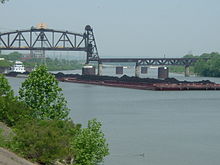 A barge hauling coal in the Louisville and Portland Canal, the only manmade section of the Ohio River
A barge hauling coal in the Louisville and Portland Canal, the only manmade section of the Ohio River
Being bounded by two of the largest rivers in North America, water transportation has historically played a major role in Kentucky's economy. Most barge traffic on Kentucky waterways consists of coal that is shipped from both the Eastern and Western Coalfields, about half of which is used locally to power many power plants located directly off the Ohio River, with the rest being exported to other countries, most notably Japan.
Many of the largest ports in the United States are located in or adjacent to Kentucky, including:
- Huntington/Tri-State (includes Ashland, KY), largest inland port and 7th largest overall
- Cincinnati-Northern Kentucky, 5th largest inland port and 43rd overall
- Louisville-Southern Indiana, 7th largest inland port and 55th overall
As a state, Kentucky ranks 10th overall in port tonnage.[81][82]
The only natural obstacle along the entire length of the Ohio River was the Falls of the Ohio, located just west of Downtown Louisville.
Subdivisions and settlements
Counties
See also: List of counties in Kentucky and Fiscal CourtKentucky is subdivided into 120 counties, the largest being Pike County at 787.6 square miles (2,040 km2), and the most populous being Jefferson County (which coincides with the Louisville Metro governmental area) with 741,096 residents as of 2010.[83]
County government, under the Kentucky Constitution of 1891, is vested in the County Judge/Executive, (formerly called the County Judge) who serves as the executive head of the county, and a legislature called a Fiscal Court. Despite the unusual name, the Fiscal Court no longer has judicial functions.
Consolidated city-county governments
Kentucky's two most populous counties, Jefferson and Fayette, have their governments consolidated with the governments of their largest cities. Louisville-Jefferson County Government (Louisville Metro) and Lexington-Fayette Urban County Government (Lexington Metro) are unique in that their city councils and county Fiscal Court structures have been merged into a single entity with a single chief executive, the Metro Mayor and Urban County Mayor, respectively. Although the counties still exist as subdivisions of the state, in reference the names Louisville and Lexington are used to refer to the entire area coextensive with the former cities and counties. Somewhat incongruously, when entering Lexington-Fayette the highway signs read "Fayette County" while most signs leading into Louisville-Jefferson simply read "Welcome to Louisville Metro."
Cities and towns
See also: List of cities in KentuckyRank City 2010 Pop 2000 Pop Δ Current Pop 1 Louisville 566,503 551,299 15,204 2 Lexington 295,803 260,512 35,291 3 Bowling Green 58,067 49,296 8,771 4 Owensboro 57,265 54,067 3,198 5 Covington 40,640 43,370 -2,730 6 Hopkinsville 31,577 30,089 1,488 7 Richmond 31,364 27,152 4,212 8 Florence 29,951 23,551 6,400 9 Georgetown 29,098 18,080 11,018 10 Henderson 28,757 27,373 1,384 11 Elizabethtown 28,531 22,542 5,989 12 Nicholasville 28,015 19,680 8,335 13 Jeffersontown 26,595 26,442 153 14 Frankfort 25,527 27,741 -2,214 15 Paducah 25,024 26,442 -1,418 The Louisville Metro government area has a 2010 population of 741,096. Under United States Census Bureau methodology, the population of Louisville was 566,503. The latter figure is the population of the so-called "balance"—the parts of Jefferson County that were either unincorporated or within the City of Louisville before the formation of the merged government in 2003. In 2010, the Louisville Combined Statistical Area (CSA) has a population of 1,451,564; including 1,061,031 in Kentucky, which is nearly one-fourth of the state's population. Since 2000, over one-third of the state's population growth has occurred in the Louisville CSA. In addition, the top 28 wealthiest places in Kentucky are in Jefferson County and seven of the 15 wealthiest counties in the state are located in the Louisville CSA.[84]
The second largest city is Lexington with a 2010 census population of 295,803 and its CSA, which includes the Frankfort and Richmond statistical areas, having a population of 687,173. The Northern Kentucky area (the seven Kentucky counties in the Cincinnati MSA) had a population of 425,483 in 2010. The metropolitan areas of Louisville, Lexington, and Northern Kentucky have a combined population of 2,173,687 as of 2010, which is 50.1% of the state's total population.
The two other fast growing urban areas in Kentucky are the Bowling Green area and the "Tri Cities Region" of southeastern Kentucky, comprising Somerset, London and Corbin.
Although only one town in the "Tri Cities", namely Somerset, currently has more than 10,000 people, the area has been experiencing heightened population and job growth since the 1990s. Growth has been especially rapid in Laurel County, which outgrew areas such as Scott and Jessamine counties around Lexington or Shelby and Nelson Counties around Louisville. London significantly grew in population in the 2000s, from 5,692 in 2000 to 7,993 in 2010. London also landed a Wal-Mart distribution center in 1997, bringing thousands of jobs to the community.
In northeast Kentucky, the greater Ashland area is an important transportation, manufacturing, and medical center. Iron and petroleum production, as well as the transport of coal by rail and barge, have been historical pillars of the region's economy. Due to a decline in the area's industrial base, Ashland has seen a sizable reduction in its population since 1990. The population of the area has since stabilized, however, with the medical service industry taking a greater role in the local economy. The Ashland area, including the counties of Boyd and Greenup, are part of the Huntington-Ashland, WV-KY-OH, Metropolitan Statistical Area (MSA). As of the 2000 census, the MSA had a population of 288,649. More than 21,000 of those people (as of 2010) reside within the city limits of Ashland.
The largest county in Kentucky by area is Pike, which contains Pikeville and suburb Coal Run Village . The county and surrounding area is the most populated region in the state that is not part of a Micropolitan Statistical Area or a Metropolitan Statistical Area containing nearly 200,000 people in five counties: Floyd County, Martin County, Letcher County, and neighboring Mingo County, West Virginia. Pike County contains slightly over 68,000 people.
Only three U.S. states have capitals with smaller populations than Kentucky's Frankfort (pop. 25,527), those being Augusta, Maine (pop. 18,560), Pierre, South Dakota (pop. 13,876), and Montpelier, Vermont (pop. 8,035).
-
Louisville is the state's largest city with a metro population of 1.2 million.
-
Lexington is the state's second largest city with a metro population of around 500,000.
-
Although Covington, Kentucky only has a population of 40,000, the Kentucky side of the Cincinnati/Northern Kentucky metropolitan area has a population of over 400,000.
Education
The University of Kentucky is Kentucky's flagship university
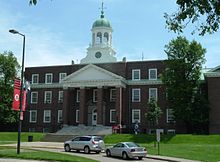 The University of Louisville is Kentucky's urban research university
The University of Louisville is Kentucky's urban research university Main article: Education in KentuckySee also: List of colleges and universities in Kentucky, List of high schools in Kentucky, and List of school districts in Kentucky
Main article: Education in KentuckySee also: List of colleges and universities in Kentucky, List of high schools in Kentucky, and List of school districts in KentuckyKentucky maintains eight public four-year universities. There are two general tiers: major research institutions (the University of Kentucky and the University of Louisville) and regional universities, which encompasses the remaining 6 schools. The regional schools have specific target counties that many of their programs are targeted towards (such as Forestry at Eastern Kentucky University or Cave Management at Western Kentucky University), however most of their curriculum varies little from any other public university. "UK" and "U of L" have the highest academic rankings and admissions standards although the regional schools aren't without their national recognized departments - examples being Western Kentucky University's nationally ranked Journalism Department or Morehead State offering one of the nation's only Space Science degrees. "UK" is the flagship and land grant of the system and has agriculture extension services in every county. The two research schools split duties related to the medical field, "UK" handles all medical outreach programs in the eastern half of the state while "U of L" does all medical outreach in the state's western half.
The state's sixteen public two-year colleges have been governed by the Kentucky Community and Technical College System since the passage of the Postsecondary Education Improvement Act of 1997, commonly referred to as House Bill 1.[85] Prior to the passage of House Bill 1, most of these colleges were under the control of the University of Kentucky.
Transylvania University, located in Lexington, is the oldest university west of the Allegheny Mountains, founded in 1780. Transylvania is a liberal arts university, consistently ranked in the top tier in the country.
Berea College, located at the extreme southern edge of the Bluegrass below the Cumberland Plateau, was the first coeducational college in the South to admit both black and white students, doing so from its very establishment in 1855.[86] This policy was successfully challenged in the United States Supreme Court in the case of Berea College v. Kentucky in 1908.[87] This decision effectively segregated Berea until the landmark Brown v. Board of Education in 1954.
Kentucky has been the site of much educational reform over the past two decades. In 1989, the Kentucky Supreme Court ruled that the state's education system was unconstitutional.[88] The response of the General Assembly was passage of the Kentucky Education Reform Act (KERA) the following year. Years later, Kentucky has shown progress, but most agree that further reform is needed.[89]
Culture
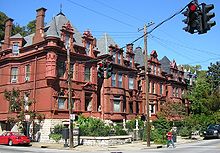 Old Louisville is the largest Victorian Historic neighborhood in the United States.
Old Louisville is the largest Victorian Historic neighborhood in the United States. Main article: Culture of KentuckySee also: Theater in Kentucky
Main article: Culture of KentuckySee also: Theater in KentuckyAlthough Kentucky's culture is generally considered to be Southern, it is unique in that it is also influenced by the Midwest and Southern Appalachia in certain areas of the state. The state is known for bourbon and whiskey distilling, tobacco, horse racing, and college basketball. Kentucky is more similar to the Upland South in terms of ancestry which is predominantly American.[90] Nevertheless, during the 19th century, Kentucky did receive a substantial number of German immigrants, who settled mostly in the Midwest, along the Ohio River primarily in Louisville, Covington and Newport.[91] Only Maryland, Delaware and West Virginia have higher German ancestry percentages than Kentucky among Census-defined Southern states, although Kentucky's percentage is closer to Arkansas and Virginia's than the previously named state's percentages. Scottish Americans, English Americans and Scotch-Irish Americans have heavily influenced Kentucky culture, and are present in every part of the state.[92] Kentucky was a slave state, and blacks once comprised over one-quarter of its population. However, it lacked the cotton plantation system and never had the same high percentage of African Americans as most other slave states. With less than 8% of its current population being black, Kentucky is rarely included in modern-day definitions of the Black Belt, despite a relatively significant rural African American population in the Central and Western areas of the state.[93][94][95] Kentucky adopted the Jim Crow system of racial segregation in most public spheres after the Civil War, but the state never disenfranchised African American citizens to the level of the Deep South states, and it peacefully integrated its schools after the 1954 Brown v. Board of Education verdict, later adopting the first state civil rights act in the South in 1966.[96]
The biggest day in horse racing, the Kentucky Derby, is preceded by the two-week Derby Festival[97] in Louisville. Louisville also plays host to the Kentucky State Fair,[98] the Kentucky Shakespeare Festival,[99] and Southern gospel's annual highlight, the National Quartet Convention.[100] Bowling Green, the state's third-largest city and home to the only assembly plant in the world that manufactures the Chevrolet Corvette,[101] opened the National Corvette Museum in 1994.[102] The fourth-largest city, Owensboro, gives credence to its nickname of "Barbecue Capital of the World" by hosting the annual International Bar-B-Q Festival.[103]
Old Louisville, the largest historic preservation district in the United States featuring Victorian architecture and the third largest overall,[104] hosts the St. James Court Art Show, the largest outdoor art show in the United States.[105] The neighborhood was also home to the Southern Exposition (1883–1887), which featured the first public display of Thomas Edison's light bulb,[106] and was the setting of Alice Hegan Rice's novel, Mrs. Wiggs of the Cabbage Patch and Fontaine Fox's comic strip, the "Toonerville Trolley.[107]
The more rural communities are not without traditions of their own, however. Hodgenville, the birthplace of Abraham Lincoln, hosts the annual Lincoln Days Celebration, and will also host the kick-off for the National Abraham Lincoln Bicentennial Celebration in February 2008. Bardstown celebrates its heritage as a major bourbon-producing region with the Kentucky Bourbon Festival.[108] (Legend holds that Baptist minister Elijah Craig invented bourbon with his black slave in Georgetown, but some dispute this claim.)[109] Glasgow mimics Glasgow, Scotland by hosting the Glasgow Highland Games, its own version of the Highland Games,[110] and Sturgis hosts "Little Sturgis", a mini version of Sturgis, South Dakota's annual Sturgis Motorcycle Rally.[111] The residents of tiny Benton even pay tribute to their favorite tuber, the sweet potato, by hosting Tater Day.[112] Residents of Clarkson in Grayson County celebrate their city's ties to the honey industry by celebrating the Clarkson Honeyfest.[113] The Clarkson Honeyfest is held the last Thursday, Friday and Saturday in September, and is the "Official State Honey Festival of Kentucky."
Music
Main article: Music of KentuckySee also: Category:Musicians from KentuckyThe breadth of music in Kentucky is indeed wide, stretching from the Purchase to the eastern mountains.
Renfro Valley, Kentucky is home to Renfro Valley Entertainment Center and the Kentucky Music Hall of Fame and is known as "Kentucky's Country Music Capital," a designation given it by the Kentucky State Legislature in the late 1980s. The Renfro Valley Barn Dance was where Renfro Valley's musical heritage began, in 1939, and influential country music luminaries like Red Foley, Homer & Jethro, Lily May Ledford & the Original Coon Creek Girls, Martha Carson, and many others have performed as regular members of the shows there over the years. The Renfro Valley Gatherin' is today America's second oldest continually broadcast radio program of any kind. It is broadcast on local radio station WRVK and a syndicated network of nearly 200 other stations across the United States and Canada every week.
Contemporary Christian music star Steven Curtis Chapman is a Paducah native, and Rock and Roll Hall of Famers The Everly Brothers are closely connected with Muhlenberg County, where older brother Don was born. Kentucky was also home to Mildred and Patty Hill, the Louisville sisters credited with composing the tune to the ditty Happy Birthday to You in 1893; Loretta Lynn (Johnson County), and Billy Ray Cyrus (Flatwoods). However, its depth lies in its signature sound—Bluegrass music. Bill Monroe, "The Father of Bluegrass", was born in the small Ohio County town of Rosine, while Ricky Skaggs, Brian Littrell and Kevin Richardson of the Backstreet Boys, Keith Whitley, David "Stringbean" Akeman, Louis Marshall "Grandpa" Jones, Sonny and Bobby Osborne, and Sam Bush (who has been compared to Monroe) all hail from Kentucky. The International Bluegrass Music Museum is located in Owensboro,[114] while the annual Festival of the Bluegrass is held in Lexington.[115]
Kentucky is also home to famed jazz musician and pioneer, Lionel Hampton (although this has been disputed in recent years).[116] Blues legend W.C. Handy and R&B singer Wilson Pickett also spent considerable time in Kentucky. The R&B group Midnight Star and Hip-Hop group Nappy Roots were both formed in Kentucky, as were country acts The Kentucky Headhunters, Montgomery Gentry and Halfway to Hazard, The Judds, as well as Dove Award-winning Christian groups Audio Adrenaline (rock) and Bride (metal). Heavy Rock band Black Stone Cherry hails from rural Edmonton, Indie rock band My Morning Jacket with lead singer and guitarist Jim James also originated out of Louisville, on the local independent music Scene. Rock band Cage the Elephant is also from Bowling Green. The bluegrass groups Driftwood and Kentucky Rain, along with Nick Lachey of the pop band 98 Degrees are also from Kentucky.
In eastern Kentucky, old-time music carries on the tradition of ancient ballads and reels developed in historical Appalachia.
Cuisine
Main article: Cuisine of KentuckyKentucky's cuisine is generally similar to traditional southern cooking, although in some areas of the state it can blend elements of both the South and Midwest.[117][118] One original Kentucky dish is called the Hot Brown, a dish normally layered in this order: toasted bread, turkey, bacon, tomatoes and topped with mornay sauce. It was developed at the Brown Hotel in Louisville.[119] The Pendennis Club in Louisville is the birthplace of the Old Fashioned cocktail. Also, western Kentucky is known for its own regional style of barbecue.
Harland Sanders originated Kentucky Fried Chicken at his service station in North Corbin, though the first franchised KFC was located in South Salt Lake, Utah.[120]
Sports
Main article: Sports in KentuckyKentucky is the home of several sports teams such as Minor League Baseball's Class A Lexington Legends and AAA Louisville Bats. They are also home to the Frontier Leagues Florence Freedom and several teams in the MCFL. The Lexington Horsemen and Louisville Fire of the af2 appear to be interested in making a move up to the "major league" Arena Football League. The northern part of the state lies across the Ohio River from Cincinnati, which is home to a National Football League team, the Bengals, and a Major League Baseball team, the Reds. It is not uncommon for fans to park in the city of Newport and use the Newport Southbank Pedestrian Bridge, locally known as the "Purple People Bridge," to walk to these games in Cincinnati. Also, Georgetown College in Georgetown is the location for the Bengals' summer training camp.[121]
As in many states, especially those without major league professional sport teams, college athletics are very important. This is especially true of the state's three Division I Football Bowl Subdivision (FBS) programs, including the Kentucky Wildcats, the Western Kentucky University Hilltoppers, and the Louisville Cardinals. The Wildcats, Hilltoppers, and Cardinals are among the most tradition-rich college basketball teams in the United States, combining for nine championships and 22 NCAA Final Fours; and all three are on the lists of total all-time wins, wins per season, and average wins per season. The Kentucky Wildcats are particularly notable, leading all Division I programs in all time wins, win percentage, NCAA tournament appearances, and being second only to UCLA in NCAA championships. Louisville has also stepped onto the football scene in recent years, with eight straight bowl games, including the 2007 Orange Bowl. Western Kentucky, the 2002 national champion in Division I-AA football (now Football Championship Subdivision (FCS), completed its transition to Division I FBS football in 2009.
Ohio Valley Wrestling in Louisville was the primary location for training and rehab for WWE professional wrestlers from 2000 until February 2008, when WWE ended its relationship with OVW and moved all of its contracted talent to Florida Championship Wrestling.
The NASCAR Sprint Cup Series will also have a race at the Kentucky Speedway in Sparta, Kentucky, an hour away from Louisville. The race will be called the Quaker State 400. The NASCAR Nationwide Series and the Camping World Truck Series also race there.
State symbols
Main article: List of Kentucky state insigniaSee also: Flag of Kentucky and Seal of KentuckyInsignia Symbol Binomial nomenclature Year Adopted[122] Official State Bird Cardinal Cardinalis cardinalis 1926 Official State Butterfly Viceroy Butterfly Limenitis archippus 1990 Official State Dance Clogging 2001 Official State Beverage Milk 2005 Official State Fish Kentucky Spotted Bass Micropterus punctulatus 2005 Official State Fossil Brachiopod undetermined 1986 Official State Flower Goldenrod Soldiago gigantea 1926 Official State Fruit Blackberry Rubus allegheniensis 2004 Official State Gemstone Freshwater Pearl 1986 State Grass Kentucky Bluegrass Poa pratensis Traditional Official State Motto "United we stand, divided we fall" 1942 Official State Latin Motto "Deo gratiam habeamus" ("Let us be grateful to God") 2002 Official State Horse Thoroughbred Equus caballus 1996 Official State Mineral Coal 1998 Official State Outdoor Musical "The Stephen Foster Story" (now called "Stephen Foster - The Musical") 2002 Official State Instrument Appalachian Dulcimer 2001 State Nickname "The Bluegrass State" Traditional Official State Rock Kentucky Agate 2000 Official State Slogan "Kentucky: Unbridled Spirit" 2004[123] Official State Soil Crider Soil Series 1990 Official State Tree Tulip Poplar Liriodendron tulipifera 1994 Official Wild Animal Game Species Gray Squirrel Sciurus carolinensis 1968 Official State Song "My Old Kentucky Home" (revised version)
1986 Official State Silverware Pattern Old Kentucky Blue Grass: The Georgetown Pattern 1996 Official State Music Bluegrass music 2007[124] Official State Automobile Chevrolet Corvette 2010 Official state places and events
- State arboretum: Bernheim Arboretum and Research Forest
- State botanical garden: The Arboretum: State Botanical Garden of Kentucky
- State Science Center: Louisville Science Center
- State center for celebration of African American heritage: Kentucky Center for African American Heritage
- State honey festival: Clarkson Honeyfest[125]
- State amphitheater: Iroquois Amphitheater (Louisville)
- State tug-o-war championship: The Fordsville Tug-of-War Championship
- Covered Bridge Capital of Kentucky: Fleming County
- Official Covered Bridge of Kentucky: Switzer Covered Bridge (Franklin County)
- Official steam locomotive of Kentucky: "Old 152" (located in the Kentucky Railway Museum in New Haven)
- Official pipe band: Louisville Pipe Band
- State bourbon festival: Kentucky Bourbon Festival, Inc., in Bardstown, Kentucky
Unless otherwise specified, all state symbol information is taken from Kentucky State Symbols.
Gallery
-
The world famous Louisville Slugger baseball bat is made in Kentucky. It holds the Guinness World Record for the largest bat.
-
Kentucky's 2001 commemorative quarter.
-
Thunder Over Louisville is the largest annual fireworks show in the world.
-
The Ohio River forms the northern border of Kentucky.
-
US Highway 23 cuts through the rugged Cumberland Plateau near Pikeville.
See also
- Outline of Kentucky
- Index of Kentucky-related articles
- List of National Register of Historic Places in Kentucky
- List of people from Kentucky
- Southern Cherokee Nation of Kentucky
- U.S. state
References
- ^ "Kentucky State Symbols". Kentucky Department for Libraries and Archives. http://kdla.ky.gov/resources/KYSymbols.htm. Retrieved 2006-11-29.
- ^ "2010 Census: Resident Population Data". 2010. http://2010.census.gov/2010census/data/apportionment-pop-text.php. Retrieved 2010-12-22.
- ^ a b "Elevations and Distances in the United States". United States Geological Survey. 2001. http://egsc.usgs.gov/isb/pubs/booklets/elvadist/elvadist.html. Retrieved October 21, 2011.
- ^ a b Elevation adjusted to North American Vertical Datum of 1988.
- ^ "State Symbols". Encyclopedia of Kentucky. New York, New York: Somerset Publishers. 1987. ISBN 0403099811.
- ^ "Native American Tribes of Kentucky"
- ^ ed. in chief Frederick C. Mish (2003). Merriam-Webster's Collegiate Dictionary (11th ed.). Merriam–Webster. p. 1562. ISBN 9780877798095. http://books.google.com/?id=O78rzaI2XmUC&pg=RA1-PA1562.
- ^ The North American Midwest: A Regional Geography. New York, New York: Wiley Publishers. 1955. ISBN 0901411931.
- ^ "Map of [1494-1557] Waterworks Rd Evansville, IN". http://www.mapquest.com/maps/map.adp?formtype=address&addtohistory=&address=%5b1494%2d1557%5d%20Waterworks%20Rd&city=Evansville&state=IN&zipcode=47713&country=US&location=sx5PfJLyNGOdfPC4XlmsmD4sYz8%2fcM%2f9UzxNAshApmBL3N63w0vZEKUJ7ZFErueQQVVT7jNm9im%2frMyLwvsq1tX3B0QnxqQNsp3LVvDC22VDK3WLmnQ83dOStm4oo36rfS7%2fgXA9L8%2b8CqYgeWZpmK5YKDtojM0V&ambiguity=1. Retrieved 2009-01-01.
- ^ "Life on the Mississippi". Kentucky Educational Television. 2002-01-28. http://www.ket.org/kentuckylife/800s/kylife804.html. Retrieved 2006-11-29.
- ^ "The Geography of Kentucky - Climate". NetState.com. 2006-06-15. http://www.netstate.com/states/geography/ky_geography.htm. Retrieved 2006-11-29.
- ^ "Geographical Configuration". Encyclopedia of Kentucky. New York, New York: Somerset Publishers. 1987. ISBN 0403099811.
- ^ Kleber, John E., ed (1992). "Rivers". The Kentucky Encyclopedia. Associate editors: Thomas D. Clark, Lowell H. Harrison, and James C. Klotter. Lexington, Kentucky: The University Press of Kentucky. ISBN 0813117720.
- ^ Kleber, John E., ed (1992). "Lakes". The Kentucky Encyclopedia. Associate editors: Thomas D. Clark, Lowell H. Harrison, and James C. Klotter. Lexington, Kentucky: The University Press of Kentucky. ISBN 0813117720.
- ^ "Corbin, Kentucky: A Fisherman's Paradise". Corbin, Kentucky Economic Development. http://www.corbinkentucky.us/fishing.htm. Retrieved 2006-11-29.
- ^ "Elk Restoration Update and Hunting Information". Kentucky Department of Fish and Wildlife Resources. Archived from the original on 2006-09-26. http://web.archive.org/web/20060926064155/http://fw.ky.gov/elkinfo.asp?lid=1653&NavPath=C117C147C301C547. Retrieved 2006-12-09.
- ^ "Hunters Take Record Number of Spring Turkey". Kentucky Department of Fish and Wildlife Service. http://fw.ky.gov/newsrelease.asp?nid=542.
- ^ S. Spacek, "2011 American State Litter Scorecard: New Rankings for an Increasingly Environmentally Concerned Populace".
- ^ "Cumberland Falls State Resort Park". Kentucky Department of Parks. 2005-10-19. Archived from the original on 2006-10-05. http://web.archive.org/web/20061005015537/http://parks.ky.gov/resortparks/cf/. Retrieved 2006-11-29.
- ^ "Mammoth Cave National Park". National Park Service. 2006-10-12. http://www.nps.gov/maca/. Retrieved 2006-11-29.
- ^ "Science In Your Backyard: Kentucky". United States Geological Survey. http://www.usgs.gov/state/state.asp?State=KY). Retrieved 2006-11-29.
- ^ "Bad Branch State Nature Preserve". Kentucky State Nature Preserves Commission. Archived from the original on October 24, 2006. http://web.archive.org/web/20061024022402/http://www.naturepreserves.ky.gov/stewardship/badbranch.htm. Retrieved 2006-11-29.
- ^ "Jefferson Memorial Forest". http://www.memorialforest.com/. Retrieved 2006-11-29.
- ^ "The Presence". History of Native Americans in Central Kentucky. Mercer County Online. http://www.merceronline.com/Native/native01.htm. Retrieved 2006-11-29.
- ^ James, James Alton (1928). The Life of George Rogers Clark. Chicago: University of Chicago Press. ISBN 0404035493.
- ^ Harrison, Lowell H (1976; Reprinted 2001). George Rogers Clark and the War in the West. Lexington: University Press of Kentucky. ISBN 0-8131-9014-2.
- ^ "About Kentucky". Ezilon Search. http://search.ezilon.com/about-kentucky.html. Retrieved 2006-11-29.
- ^ "Constitution Square State Historic Site". Danville-Boyle County Convention and Visitors Bureau. Archived from the original on 2007-10-11. http://web.archive.org/web/20071011230008/http://danville-ky.com/attractions2.php?category=History+and+Museums. Retrieved 2006-11-29.
- ^ "Border States in the Civil War". CivilWarHome.com. 2002-02-15. http://www.civilwarhome.com/borderstates.htm. Retrieved 2006-11-29.
- ^ "Ordinances of Secession". Historical Text Archive. http://historicaltextarchive.com/sections.php?op=viewarticle&artid=170. Retrieved 2006-11-29.
- ^ "Civil War Sites - Bowling Green, KY". WMTH Corporation. http://www.trailsrus.com/monuments/reg3/bowling_green.html. Retrieved 2006-11-29.
- ^ Irby, Jr., Richard E.. "A Concise History of the Flags of the Confederate States of America and the Sovereign State of Georgia". About North Georgia. Golden Ink. http://ngeorgia.com/history/flagsofga.html. Retrieved 2006-11-29.
- ^ Marx, Karl (1861-07-05). "Marx To Engels In Manchester". Marxists Internet Archive. http://marxists.org/archive/marx/works/1861/letters/61_07_05.htm. Retrieved 2006-11-29.
- ^ "KRS 2.110 Public Holidays" (PDF). Kentucky General Assembly. http://www.lrc.ky.gov/KRS/002-00/110.PDF. Retrieved 2006-11-29.
- ^ "The Old State Capitol". Kentucky Historical Society. http://history.ky.gov/sub.php?pageid=23§ionid=8. Retrieved 2007-11-09.
- ^ "Reviser of Statutes Office - History and Functions". Kentucky Legislative Research Commission. http://www.lrc.ky.gov/statrev/revoff.htm. Retrieved 2006-12-27.
- ^ "History of the DOCJT". Kentucky Department of Criminal Justice. http://docjt.jus.state.ky.us/history.html. Retrieved 2006-12-27.
- ^ "History of the Kentucky State Police". Kentucky State Police. http://www.kentuckystatepolice.org/history.htm. Retrieved 2006-12-27.
- ^ "Authorized Methods of Execution by State". Death Penalty Information Center. http://www.deathpenaltyinfo.org/methods-execution#state. Retrieved 2006-12-28.
- ^ Long, Paul A (2001-06-11). "'The Last Public Execution in America'". The Kentucky Post (E. W. Scripps Company). Archived from the original on 2006-01-17. http://web.archive.org/web/20060117233210/http://www.kypost.com/2001/jun/11/bethea061101.html. Retrieved 2006-12-27.
- ^ Montagne, Renee (2001-05-01). "The Last Public Execution in America". NPR. http://www.npr.org/programs/morning/features/2001/apr/010430.execution.html. Retrieved 2006-12-27.
- ^ "McCreary County v. ACLU of Kentucky". Cornell University Law School. http://straylight.law.cornell.edu/supct/html/03-1693.ZS.html. Retrieved 2006-12-27.
- ^ "Text of decision in ACLU of Kentucky v. Mercer County" (PDF). http://www.ca6.uscourts.gov/opinions.pdf/05a0477p-06.pdf. Retrieved 2006-12-27.
- ^ Leip, David. "Presidential General Election Results Comparison - Kentucky". US Election Atlas. http://uselectionatlas.org/RESULTS/compare.php?year=2008&fips=21&f=1&off=0&elect=0&type=state. Retrieved December 31, 2009.
- ^ "2006 General Election Registration Figures Set". Kentucky Secretary of State. 2006-10-19. Archived from the original on 2007-12-12. http://web.archive.org/web/20071212043450/http://kentucky.gov/Newsroom/sos/article61.htm. Retrieved 2006-11-30.
- ^ "Voter Registration Statistics" (PDF). Kentucky State Board of Elections. http://www.elect.ky.gov/stats/regstat.htm. Retrieved 2010-07-07.
- ^ http://ukcc.uky.edu/census/21.txt
- ^ http://2010.census.gov/2010census/data/apportionment-pop-text.php
- ^ John W. Wright, ed (2007). The New York Times 2008 Almanac. p. 178.
- ^ Price, Michael. "Migration in Kentucky: Will the Circle Be Unbroken?". Exploring the Frontier of the Future: How Kentucky Will Live, Learn and Work. University of Louisville. pp. 5–10. http://www.kltprc.net/books/exploring/Chpt_3.htm. Retrieved 30 April 2007.
- ^ "Population and Population Centers by State: 2000" (TXT). U.S. Census Bureau. http://www.census.gov/geo/www/cenpop/statecenters.txt. Retrieved 2006-12-27.
- ^ http://www.epodunk.com/cgi-bin/popInfo.php?locIndex=18
- ^ http://www.epodunk.com/cgi-bin/genInfo.php?locIndex=18
- ^ Census 2000 Map - Top U.S. Ancestries by County
- ^ "State Membership Report". The Association of Religion Data Archives. 2000. http://www.thearda.com/mapsReports/reports/state/21_2000.asp. Retrieved 2006-12-27.
- ^ Muslims in Louisville
- ^ "2007 Rankings of States and Counties". bamabeef.org. http://www.bamabeef.org/NewStateandCountyrankings05.htm. Retrieved 1 M a y 2007.
- ^ "Corn Production Detective" (PDF). National Council on Economic Education. Archived from the original on 2007-06-05. http://web.archive.org/web/20070605025350/http://www.econedlink.org/lessons/EM453/docs/em453_Corn_Production_Det_Answers.pdf. Retrieved 2007-05-03.
- ^ Utah Geological Survey - U.S. Coal Production by State, 1994-2009
- ^ url=http://www.tradeandindustrydev.com/issues/article.asp?ID=66
- ^ "GDP by State". http://greyhill.com/gdp-by-state. Retrieved 7 September 2011.
- ^ Kentucky Cabinet for Economic Development - Kentucky Economy
- ^ Bls.gov; Local Area Unemployment Statistics
- ^ "Kentucky Income Tax Rates". salary. com. http://swz.salary.com/salarywizard/layouthtmls/swzl_statetaxrate_KY.html. Retrieved May 1, 2007.
- ^ "Sales & Use Tax". Kentucky Department of Revenue. http://revenue.ky.gov/business/salesanduse.htm. Retrieved May 1, 2007.
- ^ "Property Tax". Kentucky Department of Revenue. Archived from the original on April 3, 2007. http://web.archive.org/web/20070403180310/http://revenue.ky.gov/business/proptax.htm. Retrieved May 1, 2007.
- ^ "State Taxes - Kentucky - Overview". bankrate.com. http://www.bankrate.com/yho/itax/edit/state/profiles/state_tax_Ky.asp. Retrieved 2007-05-01.
- ^ "Text of the House Bill 272". State of Kentucky. http://www.lrc.ky.gov/record/05rs/HB272.htm. Retrieved August 10, 2007.
- ^ "Unbridled Spirit→Information". State of Kentucky. http://kentucky.gov/Pages/unbridledspirit.aspx. Retrieved 2007-05-01.
- ^ Stinnett, Chuck. "Fletcher:Tolls to end November 22". Archived from the original on 2006-10-08. http://web.archive.org/web/20061008233115/http://www.kctcs.net/todaysnews/index.cfm?tn_date=2006-09-28#6693. Retrieved 2007-05-01.
- ^ Stinnett, Chuck (2006-11-22). "Onlookers Cheer Booth Destruction at Ceremony". Courier Press. http://www.courierpress.com/news/2006/nov/22/onlookers-cheer-booth-destruction-at-ceremony/. Retrieved August 10, 2007.
- ^ Steitzer, Stephanie (2007-06-26). "Many new laws go on books today". Courier-Journal. http://www.courier-journal.com/apps/pbcs.dll/article?AID=2007706260437.[dead link]
- ^ "Railroad Service in Kentucky" (PDF). Association of American Railroads. http://www.aar.org/PubCommon/Documents/AboutTheIndustry/RRState_KY.pdf. Retrieved 2007-05-01. Also, Norfolk Southern's main north-south line runs through central and southern Kentucky, starting in Cincinnati. Formerly the CNO&TP subsidiary of Southern Railway, it is NS's most profitable line.
- ^ Knight, Andy. "On the Right Track - Kentucky Dinner Train serves up railroad nostalgia". Cincinnati.com. http://www.cincinnati.com/visitorsguide/stories/071100_dinnertrain.html. Retrieved 2007-05-01.
- ^ "Kentucky Railway Museum". http://www.kyrail.org/. Retrieved 2007-05-01.
- ^ Shafer, Sheldon (2007-03-05). "Bridges money may be shifted". Courier-Journal.
- ^ Crowley, Patrick (April 23, 2003). "Meet the Purple People Bridge". Cincinnati Enquirer. http://www.enquirer.com/editions/2003/04/20/loc_purplebridge20.html. Retrieved 2007-05-01.
- ^ "Fast Facts". Louisville International Airport. http://www.flylouisville.com/About-the-Airport/About-the-Airport.aspx. Retrieved 2007-09-11.
- ^ Crash Kills 49
- ^ "Comair Crash Survivor Leaves Hospital". CBS. 2006-10-03. http://www.cbsnews.com/stories/2006/10/03/national/main2059120.shtml. Retrieved 2007-05-01.
- ^ Top 20 Inland U.S. Ports for 2003
- ^ CY 2001 Tonnage for Selected U.S. Ports by Port Tons
- ^ Kentucky Counties, University of Kentucky
- ^ "Kentucky State Data Center". Ksdc.louisville.edu. http://ksdc.louisville.edu/. Retrieved 2009-08-04.
- ^ "Postsecondary Education Improvement Act of 1997". State of Kentucky. http://www.lrc.ky.gov/recarch/97ss/HB1/bill.doc. Retrieved 2007-05-01.
- ^ "Berea College:Learning, Labor, and Service". Diversity Web. http://www.diversityweb.org/digest/vol10no1/mendel.cfm. Retrieved 2007-05-01. Berea College: Learning, Labor, and Service
- ^ Berea College v. Kentucky
- ^ "A Guide to the Kentucky Education Reform Act of 1990". Education Resources Information Center. http://eric.ed.gov/ERICWebPortal/Home.portal?_nfpb=true&_pageLabel=RecordDetails&ERICExtSearch_SearchValue_0=ED327352&ERICExtSearch_SearchType_0=eric_accno&objectId=0900000b8004b71c. Retrieved 2007-05-01.[dead link][Abstract of A Guide to the Kentucky Education Reform Act of 1990 - provided by Education Resources Information Center (ERIC)]
- ^ Roeder, Phillip. "Education Reform and Equitable Excellence: The Kentucky Experiment". http://www.kltprc.net/foresight/Chpt_37.htm. Retrieved 2007-05-01.
- ^ Brittingham, Angela & de la Cruz, G. Patricia (June 2004). "Ancestry 2000: Census 2000 Brief" (PDF). United States Census Bureau. http://www.census.gov/prod/2004pubs/c2kbr-35.pdf. Retrieved 28 June 2007.
- ^ "Kentucky's German Americans in the Civil War". Kygermanscw.yolasite.com. http://kygermanscw.yolasite.com/the-story.php. Retrieved 2010-07-02.
- ^ "2000 Census: Percent Reporting Any German Ancestry". http://www.thearda.com/mapsReports/maps/map.asp?state=101&variable=494. Retrieved 2007-07-20.
- ^ Beale, Calvin (21 July 2004). "High Poverty in the Rural U.S. and South: Progress and Persistence in the 1990s" (PowerPoint). Archived from the original on June 26, 2007. http://web.archive.org/web/20070626232430/http://srdc.msstate.edu/poverty/ppts/cromartie.ppt. Retrieved 28 June 2007.
- ^ Womack, Veronica L. (23 July 2004). "The American Black Belt Region: A Forgotten Place" (PowerPoint). Archived from the original on 26 June 2007. http://web.archive.org/web/20070626232429/http://srdc.msstate.edu/poverty/ppts/womack.ppt. Retrieved 28 June 2007.
- ^ Unknown. "Identifying the "Black Belt" of Cash-Crop Production" (JPEG Image). Bowdoin College. http://www.bowdoin.edu/~prael/branch/ex1/m4-black-belt.jpg. Retrieved 28 June 2007.
- ^ "Civil Rights and Women's Rights". Civil Rights and Women's Rights. http://encarta.msn.com/encyclopedia_761554924_12/Kentucky.html. Retrieved 2007-07-20.
- ^ "Derby Festival Home Page". http://www.derbyfestival.org/. Retrieved 2011-05-13.
- ^ "Kentucky State Fair". http://www.kystatefair.org/. Retrieved 2006-12-25.
- ^ "Kentucky Shakespeare Festival Home Page". http://www.kyshakes.org/. Retrieved 2006-12-25.
- ^ "National Quartet Convention Home Page". http://www.natqc.com/. Retrieved 2006-12-25.
- ^ "National Corvette Museum press release". Archived from the original on 2007-12-27. http://web.archive.org/web/20071227111243/http://bg.ky.net/Corvette/newera.htm. Retrieved 2006-12-25.
- ^ "National Corvette Museum Home Page". http://www.corvettemuseum.com/. Retrieved 2006-12-25.
- ^ "Home Page of the International Barbecue Festival". http://www.bbqfest.com/. Retrieved 2006-12-25.
- ^ "Stately Mansions Grace Old Louisville". Atlanta Journal Constitution. http://www.ajc.com/travel/content/travel/southeast/ky_stories/0305/09lvgetaway.html. Retrieved 2006-12-25.
- ^ "St. James Court Art Show Home Page". http://www.stjamescourtartshow.com/. Retrieved 2006-12-25.
- ^ "The Heart Line" (PDF). Kentucky Commission on Community Volunteerism and Service. http://chfs.ky.gov/NR/rdonlyres/6AD56B4B-7551-4E34-AE5B-E067472C503E/0/October_2004.pdf. Retrieved 2006-12-25.
- ^ "Old Louisville and Literature". http://www.oldlouisville.com/literature/. Retrieved 2006-12-25.
- ^ "Kentucky Bourbon Festival Home Page". http://www.kybourbonfestival.com/. Retrieved 2006-12-25.
- ^ "How Bourbon Whiskey Really Got Its Famous Name". http://www.straightbourbon.com/articles/ccname.html. Retrieved 2006-12-25.
- ^ "Glasgow, Kentucky Highland Games Home Page". http://www.glasgowhighlandgames.com/. Retrieved 2006-12-25.
- ^ "Little Sturgis Rally Home Page". http://www.littlesturgisrally.net/. Retrieved 2006-12-25.
- ^ "Tater Day Festival A Local Legacy". http://www.americaslibrary.gov/cgi-bin/page.cgi/es/ky/tater_1. Retrieved 2006-12-25.
- ^ "Clarkson Honeyfest home page". http://www.honeyfest.com/. Retrieved 2007-05-12.
- ^ "International Bluegrass Music Museum". http://www.bluegrass-museum.org/. Retrieved 2006-11-30.
- ^ "Festival of the Bluegrass Home Page". http://www.festivalofthebluegrass.com/. Retrieved 2006-11-30.
- ^ Voce, Steve (2002-09-02). "Obituary: Lionel Hampton". The Independent. http://findarticles.com/p/articles/mi_qn4158/is_20020902/ai_n12639955/pg_5. Retrieved 2007-06-03.[dead link]
- ^ "Southern Recipes - Southern Food and Recipes". Southernfood.about.com. 2009-06-17. http://southernfood.about.com/od/southernregionalfood/Southern_Recipes_and_Regional_Specialties.htm. Retrieved 2009-08-04.
- ^ "International Institute of Culinary Arts". Archived from the original on 2008-01-06. http://web.archive.org/web/20080106091226/www.iicaculinary.com/iica-curr.htm#ac303.
- ^ "Hot Brown Recipe". Brown Hotel. Archived from the original on August 23, 2007. http://web.archive.org/web/20070823065032/http://www.brownhotel.com/dining/hot-brown.html. Retrieved 2006-12-18.
- ^ Jenifer K. Nii (2004). "Colonel's landmark KFC is mashed". Deseret Morning News. http://www.deseretnews.com/article/1,5143,595057690,00.html. Retrieved on October 28, 2007.
- ^ "About the camp". BengalsCamp.com. http://www.bengalscamp.com. Retrieved 2006-12-18.
- ^ "Kentucky's State Symbols". Kentucky Department of Libraries and Archives. http://kdla.ky.gov/resources/KYSymbols.htm. Retrieved 2006-12-18.
- ^ "Unbridled Spirit Information". Kentucky.gov. 2006-11-20. http://www.kentucky.gov/unbridledspirit/info.htm. Retrieved 2006-12-18.
- ^ "HB71: An act designating bluegrass music as the official state music of Kentucky" (DOC). Legislative Research Commission. http://www.lrc.ky.gov/RECORD/07RS/HB71/bill.doc. Retrieved 2007-06-26.
- ^ "KRS 2.099 - State Honey Festival" (PDF). Kentucky General Assembly. http://www.lrc.ky.gov/KRS/002-00/099.PDF. Retrieved 2006-12-18.
Bibliography
Politics
- Miller, Penny M. Kentucky Politics & Government: Do We Stand United? (1994)
- Jewell, Malcolm E. and Everett W. Cunningham, Kentucky Politics (1968)
History
Surveys and reference
- Bodley, Temple and Samuel M. Wilson. History of Kentucky 4 vols. (1928).
- Caudill, Harry M., Night Comes to the Cumberlands (1963). ISBN 0-316-13212-8
- Channing, Steven. Kentucky: A Bicentennial History (1977).
- Clark, Thomas Dionysius. A History of Kentucky (many editions, 1937–1992).
- Collins, Lewis. History of Kentucky (1880).
- Harrison, Lowell H. and James C. Klotter. A New History of Kentucky (1997).
- Kleber, John E. et al. The Kentucky Encyclopedia (1992), standard reference history.
- Klotter, James C. Our Kentucky: A Study of the Bluegrass State (2000), high school text
- Lucas, Marion Brunson and Wright, George C. A History of Blacks in Kentucky 2 vols. (1992).
- Notable Kentucky African Americans http://www.uky.edu/Subject/aakyall.html
- Share, Allen J. Cities in the Commonwealth: Two Centuries of Urban Life in Kentucky (1982).
- Wallis, Frederick A. and Hambleton Tapp. A Sesqui-Centennial History of Kentucky 4 vols. (1945).
- Ward, William S., A Literary History of Kentucky (1988) (ISBN 0-87049-578-X).
- WPA, Kentucky: A Guide to the Bluegrass State (1939), classic guide.
- Yater, George H. (1987). Two Hundred Years at the Fall of the Ohio: A History of Louisville and Jefferson County (2nd ed.). Filson Club, Incorporated. ISBN 0-9601072-3-1.
Specialized scholarly studies
- Bakeless, John. Daniel Boone, Master of the Wilderness (1989)
- Blakey, George T. Hard Times and New Deal in Kentucky, 1929–1939 (1986)
- Coulter, E. Merton. The Civil War and Readjustment in Kentucky (1926)
- Davis, Alice. "Heroes: Kentucky's Artists from Statehood to the New Millennium" (2004)
- Ellis, William E. The Kentucky River (2000).
- Faragher, John Mack. Daniel Boone (1993)
- Fenton, John H. Politics in the Border States: A Study of the Patterns of Political Organization, and Political Change, Common to the Border States: Maryland, West Virginia, Kentucky, and Missouri (1957)
- Ireland, Robert M. The County in Kentucky History (1976)
- Klotter, James C.; Lowell Harrison, James Ramage, Charles Roland, Richard Taylor, Bryan S. Bush, Tom Fugate, Dixie Hibbs, Lisa Matthews, Robert C. Moody, Marshall Myers, Stuart Sanders and Stephen McBride (2005). Jerlene Rose. ed. Kentucky's Civil War 1861–1865. Back Home In Kentucky Inc. ISBN 0-9769231-1-4.
- Klotter, James C. Kentucky: Portrait in Paradox, 1900–1950 (1992)
- Pearce, John Ed. Divide and Dissent: Kentucky Politics, 1930–1963 (1987)
- Remini, Robert V. Henry Clay: Statesman for the Union (1991).
- Sonne, Niels Henry. Liberal Kentucky, 1780–1828 (1939)
- Tapp, Hambleton and James C Klotter. Kentucky Decades of Discord, 1865–1900 (1977)
- Townsend, William H. Lincoln and the Bluegrass: Slavery and Civil War in Kentucky (1955)
- Waldrep, Christopher Night Riders: Defending Community in the Black Patch, 1890–1915 (1993) tobacco wars
External links
- Kentucky.gov: My New Kentucky Home
- Kentucky State and County Government Websites
- Kentucky State Databases - Annotated list of searchable databases produced by Kentucky state agencies and compiled by the Government Documents Roundtable of the American Library Association.
- Kentucky at the Open Directory Project
- Kentucky Department of Tourism
- Kentucky travel guide from Wikitravel
- The Kentucky Highlands Project
- USGS real-time, geographic, and other scientific resources of Kentucky
- Energy & Environmental Data for Kentucky
- Kentucky State Facts
- Kentucky: Unbridled Spirit
- Kentucky Virtual Library
- "Science In Your Backyard: Kentucky" U.S. Department of the Interior | U.S. Geological Survey, July 3, 2006, retrieved November 4, 2006
- U.S. Census Bureau Kentucky QuickFacts
 OpenStreetMap has geographic data related to Kentucky
OpenStreetMap has geographic data related to Kentucky- Kentucky at Ballotpedia

 Indiana •
Indiana •  Ohio
Ohio West Virginia
West Virginia
 Illinois
Illinois
 Missouri
Missouri
 Virginia
Virginia Kentucky: Outline • Index
Kentucky: Outline • Index 

 Arkansas
Arkansas Tennessee
Tennessee North Carolina
North CarolinaPolitical divisions of the United States States - Alabama
- Alaska
- Arizona
- Arkansas
- California
- Colorado
- Connecticut
- Delaware
- Florida
- Georgia
- Hawaii
- Idaho
- Illinois
- Indiana
- Iowa
- Kansas
- Kentucky
- Louisiana
- Maine
- Maryland
- Massachusetts
- Michigan
- Minnesota
- Mississippi
- Missouri
- Montana
- Nebraska
- Nevada
- New Hampshire
- New Jersey
- New Mexico
- New York
- North Carolina
- North Dakota
- Ohio
- Oklahoma
- Oregon
- Pennsylvania
- Rhode Island
- South Carolina
- South Dakota
- Tennessee
- Texas
- Utah
- Vermont
- Virginia
- Washington
- West Virginia
- Wisconsin
- Wyoming
Federal district Insular areas Outlying islands Preceded by
VermontList of U.S. states by date of statehood
Admitted on June 1, 1792 (15th)Succeeded by
TennesseeCoordinates: 37°30′N 85°00′W / 37.5°N 85°W
United States (Outline) History Pre-Columbian era · Colonial era (Thirteen Colonies · Colonial American military history) · American Revolution (War) · Federalist Era · War of 1812 · Territorial acquisitions · Territorial evolution · Mexican–American War · Civil War · Reconstruction era · Indian Wars · Gilded Age · African-American Civil Rights Movement (1896–1954) · Spanish–American War · Imperialism · World War I · Roaring Twenties · Great Depression · World War II (Home front) · Cold War · Korean War · Space Race · African-American Civil Rights Movement (1955–1968) · Feminist Movement · Vietnam War · Post-Cold War (1991–present) · War on Terror (War in Afghanistan · Iraq War) · Timeline of modern American conservatismTopicsDemographic · Discoveries · Economic (Debt Ceiling) · Inventions (before 1890 · 1890–1945 · 1946–1991 · after 1991) · Military · Postal · Technological and industrialFederal
governmentLegislature - Congress
Senate
· Vice President
· President pro tem
House of Representatives
· Speaker
Judiciary - Supreme Court
Federal courts
Courts of appeal
District courtsExecutive - President
Executive Office
Cabinet / Executive departments
Civil service
Independent agencies
Law enforcement
Public policy
Intelligence
Central Intelligence Agency
Defense Intelligence Agency
National Security Agency
Federal Bureau of InvestigationPolitics Divisions · Elections (Electoral College) · Foreign policy · Foreign relations · Ideologies · Local governments · Parties (Democratic Party · Republican Party · Third parties) · Political status of Puerto Rico · Red states and blue states · Scandals · State governments · Uncle SamGeography Cities, towns, and villages · Counties · Extreme points · Islands · Mountains (Peaks · Appalachian · Rocky) · National Park System · Regions (Great Plains · Mid-Atlantic · Midwestern · New England · Northwestern · Southern · Southwestern · Pacific · Western) · Rivers (Colorado · Columbia · Mississippi · Missouri · Ohio · Rio Grande) · States · Territory · Water supply and sanitationEconomy Agriculture · Banking · Communications · Companies · Dollar · Energy · Federal Budget · Federal Reserve System · Financial position · Insurance · Mining · Public debt · Taxation · Tourism · Trade · Transportation · Wall StreetSociety TopicsCrime · Demographics · Education · Family structure · Health care · Health insurance · Incarceration · Languages (American English · Spanish · French) · Media · People · Public holidays · Religion · SportsArchitecture · Art · Cinema · Cuisine · Dance · Fashion · Flag · Folklore · Literature · Music · Philosophy · Radio · Television · TheaterIssuesCategories:- Kentucky
- States of the United States
- States of the Southern United States
- States and territories established in 1792
-
Wikimedia Foundation. 2010.

